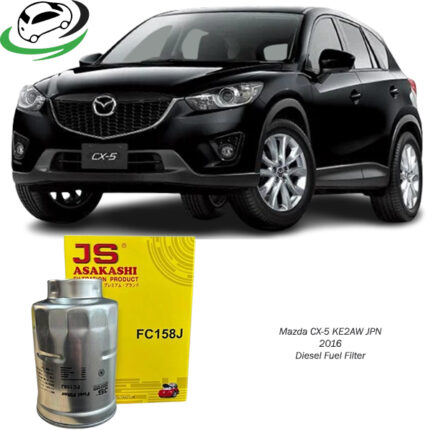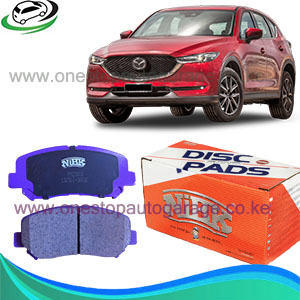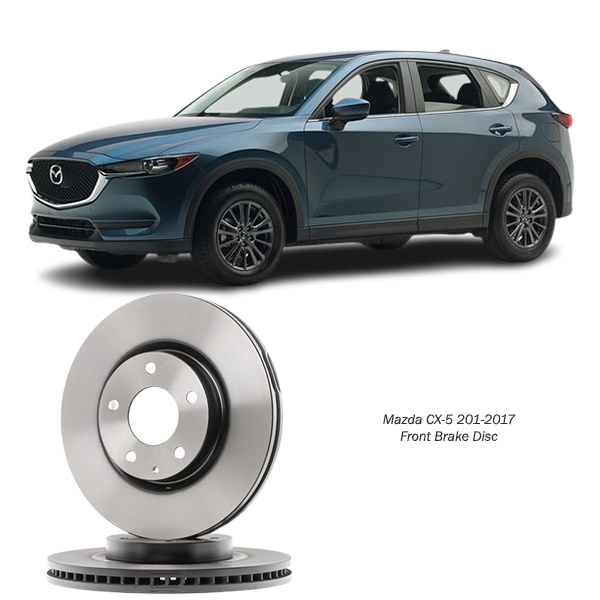-10%
Get Mazda CX-5 2011-2017 Front Brake Disc K011-33-251A in Kenya
A front brake disc, also known as a brake rotor, is a vital component of a vehicle’s braking system. It plays a crucial role in slowing down or stopping the vehicle by converting kinetic energy into heat energy through friction. This detailed guide will explore the function, types, materials, advantages, maintenance, and troubleshooting of front brake discs to give you a complete understanding of their importance in modern vehicles.
What is a Front Brake Disc?
The front brake disc is a circular metal component connected to the wheel hub. When you press the brake pedal, the brake caliper squeezes the brake pads against the rotating disc, creating friction that slows the wheel. This system is widely used in modern vehicles due to its efficiency and reliability.
Front brake discs are more heavily utilized than rear brake discs because of weight distribution during braking. When you apply the brakes, the car’s weight shifts forward, placing more demand on the front braking system.
How Does a Front Brake Disc Work?
- Brake Pedal Application:
Pressing the brake pedal activates the hydraulic system, pushing brake fluid through lines to the brake calipers. - Brake Pad Contact:
The calipers press the brake pads against the spinning brake disc. - Friction Generation:
The contact between the brake pads and disc generates friction, slowing the rotation of the wheel. - Heat Dissipation:
The brake disc absorbs and dissipates the heat generated, preventing overheating.
Types of Front Brake Discs
Front brake discs come in various designs to suit different driving conditions and vehicle types:
- Solid Discs:
- These are simple, flat discs.
- Best suited for smaller vehicles and lighter loads.
- Affordable and durable but less effective at dissipating heat.
- Vented Discs:
- Feature internal vanes that improve airflow.
- Ideal for vehicles that experience heavy braking, such as trucks or performance cars.
- Better heat dissipation than solid discs.
- Slotted Discs:
- Have grooves on the surface to improve heat and gas expulsion.
- Suitable for high-performance vehicles.
- Enhance braking in wet conditions but wear pads faster.
- Drilled Discs:
- Include small holes for improved cooling and water drainage.
- Common in sports cars.
- Prone to cracking under extreme stress.
- Combination Discs (Drilled and Slotted):
- Combine features of drilled and slotted discs.
- Deliver superior performance in high-temperature and high-stress conditions.
Materials Used in Front Brake Discs
- Cast Iron:
- Most common material due to its durability and cost-effectiveness.
- Offers good thermal conductivity but is relatively heavy.
- Carbon-Ceramic:
- Lightweight and resistant to high temperatures.
- Found in high-performance or luxury vehicles.
- Expensive and requires specialized maintenance.
- Steel:
- Lightweight alternative to cast iron.
- Suitable for specific performance applications.
- Composite Materials:
- Combine metals and ceramics for better heat resistance and durability.
- Often used in racing applications.
Advantages of Front Brake Discs
- Effective Heat Dissipation:
- Their design prevents overheating during repeated braking.
- Improved Braking Performance:
- Provide consistent braking power, even at high speeds.
- Durability:
- High-quality discs are resistant to wear and tear, ensuring longevity.
- Adaptability:
- Suitable for various driving conditions, from city commutes to high-performance racing.
- Safety:
- Shortens stopping distances, enhancing overall vehicle safety.
Signs of a Worn or Damaged Front Brake Disc
Over time, brake discs wear down due to the intense friction and heat they endure. Common signs of wear include:
- Vibration or Pulsation:
- Felt in the brake pedal or steering wheel, often caused by warped discs.
- Squealing or Grinding Noise:
- Indicates worn brake pads that may be damaging the disc.
- Reduced Braking Performance:
- Longer stopping distances or decreased responsiveness.
- Visible Grooves or Cracks:
- Indicate excessive wear or heat damage.
- Corrosion:
- Rust buildup can occur on discs not frequently used.
- Burnt Smell:
- Sign of overheating during extended or heavy braking.
Maintaining Front Brake Discs
Proper maintenance of front brake discs ensures their longevity and optimal performance. Follow these tips:
- Regular Inspection:
- Inspect brake discs and pads for wear and tear every 10,000-15,000 miles.
- Replace Worn Brake Pads:
- Brake pads should be replaced before they completely wear out to protect the disc.
- Avoid Overheating:
- Allow the brakes to cool after heavy use, especially during high-speed driving or towing.
- Keep Discs Clean:
- Remove dirt, debris, or rust regularly to maintain smooth braking.
- Use High-Quality Components:
- Invest in premium brake discs and pads for better performance and durability.
- Flush Brake Fluid:
- Replace brake fluid every 2-3 years to maintain hydraulic efficiency.
Replacing Front Brake Discs
Replacing worn or damaged brake discs is a crucial part of vehicle maintenance. Here’s how the process typically unfolds:
- Preparation:
- Gather tools such as a jack, lug wrench, and brake cleaner. Ensure safety by parking on a level surface and using wheel chocks.
- Remove the Wheel:
- Loosen the lug nuts, lift the vehicle with a jack, and remove the wheel to access the brake assembly.
- Detach the Brake Caliper:
- Unbolt the caliper and suspend it using a hook or wire to avoid strain on the brake hose.
- Remove the Old Disc:
- Unscrew the retaining bolts and slide the disc off the hub.
- Install the New Disc:
- Clean the hub surface, position the new disc, and secure it with bolts.
- Reassemble the Brake System:
- Reattach the caliper and brake pads.
- Test the Brakes:
- Lower the vehicle, pump the brake pedal to restore pressure, and test the brakes at low speed.
Common Issues with Front Brake Discs
- Warping:
- Caused by excessive heat or uneven torque on lug nuts.
- Cracking:
- Often results from stress or using drilled discs in extreme conditions.
- Glazing:
- Occurs when the disc surface becomes smooth, reducing friction.
- Rust and Corrosion:
- Develops when discs are exposed to moisture and not used regularly.
Choosing the Right Front Brake Disc
Selecting the appropriate brake disc depends on your driving style and vehicle requirements. Consider these factors:
- Vehicle Type:
- Standard vehicles may use solid or vented discs, while performance cars benefit from slotted or drilled discs.
- Driving Conditions:
- Frequent towing or high-speed driving may require specialized discs with better heat dissipation.
- Material Quality:
- Invest in durable materials like carbon-ceramic for demanding applications.
- Budget:
- Choose a disc that balances cost with performance and durability.
FAQs About Front Brake Discs
- How long do front brake discs last?
- Typically, they last between 30,000 to 70,000 miles, depending on driving habits and conditions.
- Can I resurface a brake disc?
- Yes, but only if it meets the manufacturer’s minimum thickness specifications.
- Should I replace discs in pairs?
- Always replace discs on both sides of an axle to ensure balanced braking.
- What causes uneven wear on brake discs?
- Issues like misaligned calipers, uneven torque, or worn suspension components.
Conclusion
The front brake disc is a cornerstone of a vehicle’s braking system, providing the necessary friction to ensure safe and effective stopping power. Understanding its functions, types, and maintenance can help vehicle owners maximize performance, ensure safety, and avoid costly repairs. Regular inspections, high-quality components, and prompt replacements are key to maintaining your vehicle’s braking efficiency.
Follow us on Facebook for more parts.



